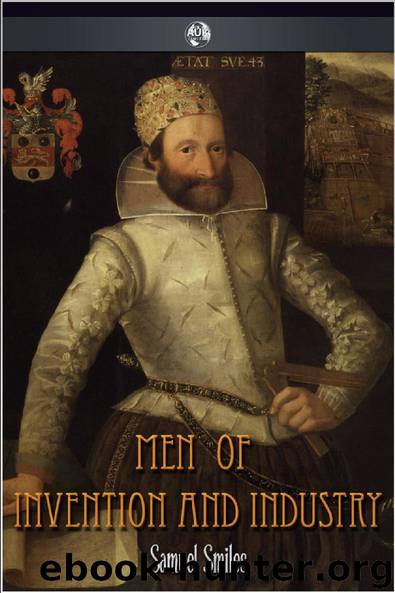Men of Invention and Industry by Samuel Smiles

Author:Samuel Smiles
Language: eng
Format: epub
ISBN: 9781781665480
Publisher: Andrews UK Limited 2012
Published: 2012-06-20T00:00:00+00:00
CHAPTER VIII.
WILLIAM CLOWES: INTRODUCER OF BOOK-PRINTING BY STEAM.
"The Images of men's wits and knowledges remain in Books, exempted from the wrong of time, and capable of perpetual renovation. Neither are they fitly to be called Images, because they generate still, and cast their seeds in the minds of others, provoking and causing infinite actions and opinions in succeeding ages; so that, if the invention of the Ship was thought so noble, which carrieth riches and commodities from place to place, and consociateth the most remote Regions in participation of their Fruits, how much more are letters to be magnified, which, as Ships, pass through the vast Seas of time, and make ages so distant to participate of the wisdom, illuminations, and inventions, the one of the other?" - Bacon, On the Proficience and Advancement of Learning.
Steam has proved as useful and potent in the printing of books as in the printing of newspapers. Down to the end of last century, "the divine art," as printing was called, had made comparatively little progress. That is to say, although books could be beautifully printed by hand labour, they could not be turned out in any large numbers.
The early printing press was rude. It consisted of a table, along which the forme of type, furnished with a tympan and frisket, was pushed by hand. The platen worked vertically between standards, and was brought down for the impression, and raised after it, by a common screw, worked by a bar handle. The inking was performed by balls covered with skin pelts; they were blacked with ink, and beaten down on the type by the pressman. The inking was consequently irregular.
In 1798, Earl Stanhope perfected the press that bears his name. He did not patent it, but made his invention over to the public. In 1818, Mr. Cowper greatly improved the inking of formes used in the Stanhope and other presses, by the use of a hand roller covered with a composition of glue and treacle, in combination with a distributing table. The ink was thus applied in a more even manner, and with a considerable decrease of labour. With the Stanhope Press, printing was as far advanced as it could possibly be by means of hand labour. About 250 impressions could be taken off, on one side, in an hour.
But this, after all, was a very small result. When books could be produced so slowly, there could be no popular literature. Books were still articles for the few, instead of for the many. Steam power, however, completely altered the state of affairs. When Koenig invented his steam press, he showed by the printing of Clarkson's 'Life of Penn' - the first sheets ever printed with a cylindrical press - that books might be printed neatly, as well as cheaply, by the new machine. Mr. Bensley continued the process, after Koenig left England; and in 1824, according to Johnson in his 'Typographia,' his son was "driving an extensive business."
In the following year, 1825, Archibald Constable, of Edinburgh, propounded his plan for revolutionising the art of bookselling.
Download
This site does not store any files on its server. We only index and link to content provided by other sites. Please contact the content providers to delete copyright contents if any and email us, we'll remove relevant links or contents immediately.
Whiskies Galore by Ian Buxton(41877)
Introduction to Aircraft Design (Cambridge Aerospace Series) by John P. Fielding(33064)
Small Unmanned Fixed-wing Aircraft Design by Andrew J. Keane Andras Sobester James P. Scanlan & András Sóbester & James P. Scanlan(32743)
Craft Beer for the Homebrewer by Michael Agnew(18140)
Turbulence by E. J. Noyes(7935)
The Complete Stick Figure Physics Tutorials by Allen Sarah(7307)
Kaplan MCAT General Chemistry Review by Kaplan(6866)
The Thirst by Nesbo Jo(6826)
Bad Blood by John Carreyrou(6548)
Modelling of Convective Heat and Mass Transfer in Rotating Flows by Igor V. Shevchuk(6391)
Learning SQL by Alan Beaulieu(6209)
Weapons of Math Destruction by Cathy O'Neil(6142)
Man-made Catastrophes and Risk Information Concealment by Dmitry Chernov & Didier Sornette(5921)
Digital Minimalism by Cal Newport;(5663)
Life 3.0: Being Human in the Age of Artificial Intelligence by Tegmark Max(5474)
iGen by Jean M. Twenge(5366)
Secrets of Antigravity Propulsion: Tesla, UFOs, and Classified Aerospace Technology by Ph.D. Paul A. Laviolette(5309)
Design of Trajectory Optimization Approach for Space Maneuver Vehicle Skip Entry Problems by Runqi Chai & Al Savvaris & Antonios Tsourdos & Senchun Chai(5011)
Pale Blue Dot by Carl Sagan(4909)
